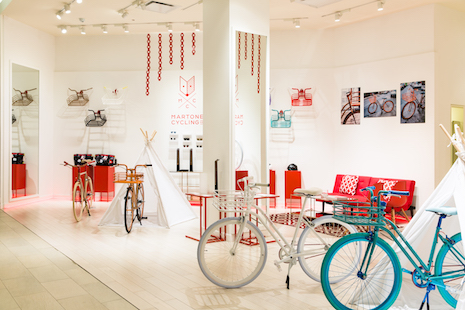 Four Seasons Hotels guests can experience guided lessons from health experts
Four Seasons Hotels guests can experience guided lessons from health experts
The United States’ current political and social tensions have opened opportunities for brands that support consumer aspirations of balance, health and connections, causing challenges to arise for traditional luxury players. According to a new report from Sustainable Brands, consumers in the United States are redefining what it means to “live the good life” by moving away from material goods and consumption and more toward life fulfillment. As a result, Sustainable Brands’ “Enabling the Good Life Report” with Harris Poll found that 80 percent of consumers would be loyal to a brand if it helped them to achieve and live their personal values.
“I'm not sure it’s any different for the luxury industry than for brands in any other category," said KoAnn Vikoren Skrzyniarz, founder/CEO of Sustainable Life Media, producers of Sustainable Brands, San Francisco. "I don't expect our desire for quality, unique design or craftsmanship will disappear.
"Brands are being less relevant to companies and loyalty is showing erosion," she said. "We’re seeing that a very significant portion of U.S. consumers would not care if 70 percent of the brands they buy disappeared.
"Buying bling just for status is definitely at risk, but on the flip side there is opportunity for redefining brand value propositions for luxury brands if they find a way to embed some kind of authentic, brand relevant way to help customers build more balance, simplicity into their lives or help them feel more connected to their community or the environment. If they don't they are likely to become irrelevant."
Sustainable Brands and Harris Poll surveyed 1,000 adults over the age of 18 in the United States in April 2017. Livin' the good life Consumers in the U.S. have shifted sentiment dramatically recently due to the country’s divisive political landscape, global conflicts and societal issues at home. These factors have contributed to the new U.S. zeitgeist across geographies, demographics, political spectrum and personal belief systems. As consumer outlook has changed, the definition of what constitutes a good life has been redefined. Per the report, 71 percent of respondents said living the good life is very different than what defined the life of their parents. Today there is an increasing focus and emphasis on simplicity, health, people and looking beyond oneself, rather than material goods. Whereas a high-end car or large home, for example, were once signifiers of success and wealth, today’s consumers would rather live simply and incorporate wellness into their everyday lives. As the report suggests, traditional symbols of the “good life,” such as wealth and the access and opportunity it once provided, are shifting. This shift has lead to two defining themes that categorize a good life: meaningful connections and balanced simplicity. Seventy-six percent of respondents believe that a good life is defined by having meaningful connections with family and the larger community. This also includes helping those in need and supporting environmental causes. The second theme, balanced simplicity, is defined by good health and simple living. Sixty-six percent of respondents explained that having a balanced life is important and have set out to reduce complexity and embrace healthy behaviors to achieve happiness. Although 78 percent of Americans surveyed believe that money cannot buy happiness, 62 percent report that income is an obstacle. When asked about how brands contribute to achieving the good life, 51 percent of respondents feel that companies care about helping consumers achieve their definition. Three quarters of respondents also feel that if consumers demanded products and services that align with the today’s definition of the good life, brands would actively respond accordingly. But, the majority of U.S. consumers, 65 percent, said that products and services offered do not help achieve their version of the good life. Even more, few see a logical path between a brand and forging a connection with other individuals, societal issues and the community. Sectors of success Food and technology brands have made strides to connect their businesses with consumers, issues and the community, at a rate of 48 percent and 45 percent, respectively. The travel and leisure sector has ensured that its properties and on-site programs help guests obtain their good life goals. Forty percent of respondents believe that the travel and leisure sector has delivered. Four Seasons Hotels & Resorts, for example, is celebrating Global Wellness Day around the world at many of its international locations this June. Global Wellness Day on June 10 is dedicated to physical and emotional health and is celebrated around the world as a time to focus on self-care. Four Seasons is taking this opportunity to lavish its customers with health and wellness events led by experts in the field. Image courtesy of Four Seasons
These events span from workout sessions, nutritional lessons, guided meditations and many other classes and events dedicated to helping customers keep their bodies and minds in top shape (see story).
In comparison, fashion is said to only deliver on helping achieve the good life 25 percent of the time.
Increasingly, fashion retailers are taking a holistic approach to wellness through in-store initiatives.
Department store chain Saks Fifth Avenue, for instance, has added more than 1,200 fitness classes to available in-store amenities at its New York flagship as wellness takes hold of luxury retail.
Image courtesy of Four Seasons
These events span from workout sessions, nutritional lessons, guided meditations and many other classes and events dedicated to helping customers keep their bodies and minds in top shape (see story).
In comparison, fashion is said to only deliver on helping achieve the good life 25 percent of the time.
Increasingly, fashion retailers are taking a holistic approach to wellness through in-store initiatives.
Department store chain Saks Fifth Avenue, for instance, has added more than 1,200 fitness classes to available in-store amenities at its New York flagship as wellness takes hold of luxury retail.
 Martone Cycling shop within Saks' The Wellery
Located on the flagship’s second floor, The Wellery concept shop is a first-of-its-kind space that offers Saks consumers immersive experiences dedicated to wellness. Millennial consumers, a segment retailers have struggled to capture, are deeply invested in self care resulting in a number of recent launches geared toward health and wellness (see story).
To increase standing among consumers, Sustainable Brands recommends brands work on deeper engagement practices to better understand target demographics and to reimagine and create products and services that matter within the parameters of the new definition of the good life.
"There’s a risk for anyone who tries to bolt on a purpose that is not really meaningful for the brand and aligned," Sustainable Brands' Ms. Vikoren Skrzyniarz said.
"We believe that cause-marketing that is arm length from the core brand is becoming more suspect," she said. "People see it as a marketing ploy. It has to be relevant.
"People are getting tired of accumulating things -- play on and remind people of that. Buy fewer, higher-quality things that honor craftsmanship and the craftsmen, that’s very on trend.”
Martone Cycling shop within Saks' The Wellery
Located on the flagship’s second floor, The Wellery concept shop is a first-of-its-kind space that offers Saks consumers immersive experiences dedicated to wellness. Millennial consumers, a segment retailers have struggled to capture, are deeply invested in self care resulting in a number of recent launches geared toward health and wellness (see story).
To increase standing among consumers, Sustainable Brands recommends brands work on deeper engagement practices to better understand target demographics and to reimagine and create products and services that matter within the parameters of the new definition of the good life.
"There’s a risk for anyone who tries to bolt on a purpose that is not really meaningful for the brand and aligned," Sustainable Brands' Ms. Vikoren Skrzyniarz said.
"We believe that cause-marketing that is arm length from the core brand is becoming more suspect," she said. "People see it as a marketing ploy. It has to be relevant.
"People are getting tired of accumulating things -- play on and remind people of that. Buy fewer, higher-quality things that honor craftsmanship and the craftsmen, that’s very on trend.”
